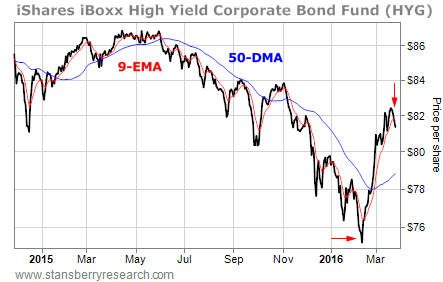Last week, I shared three reasons to be bearish right now.
And on Thursday, a fourth reason came into the picture when high-yield (or “junk”) bonds took a turn for the worst.
[ad#Google Adsense 336×280-IA]Let me explain…
The action in the stock market tends to follow the action in junk bonds.
It’s the classic “risk on/risk off” relationship.
When investors are willing to take on risk to seek higher returns, they buy junk bonds.
Then, they buy stocks.
When investors turn conservative and seek to protect capital, they sell junk bonds. Then, they sell stocks.
I told Growth Stock Wire readers about this relationship in November 2014. Back then, the action in junk bonds led the action in the stock market by about two weeks.
The lag time has lessened since then. Now, it’s just a matter of a few days before the stock market falls in line with the junk-bond market. For example, the junk-bond market bottomed this year on February 10. The S&P 500 hit its bottom for the year so far just one day later.
That’s why Thursday’s action in the high-yield bond sector is such a concern. Take a look at this chart of the iShares iBoxx High Yield Corporate Bond Fund (HYG)…

From its low in mid-February to its high on March 18, HYG gained 10%. That’s an insane move for a bond fund in less than six weeks, and it nearly matches the 13% gain in the S&P 500 during that span.
But if you look closely, you’ll notice that once HYG was able to rally above its nine-day exponential moving average (EMA) – represented by the red line on the chart – the nine-day EMA provided support to the junk-bond rally for almost six weeks.
Every time HYG fell and tested its nine-day EMA, support held. And the rally continued… until last Thursday.
Thursday’s selloff in the junk-bond sector pushed HYG below its nine-day EMA. That’s a short-term bearish sign, and it brings the 50-day moving average (the blue line) into play.
A bigger concern, though, is how a junk-bond decline could affect the stock market. We had similar caution signs here and here. And in both instances, the S&P 500 declined more than 13% within the next three months.
So Thursday’s decline in the high-yield bond market is just another reason to be concerned about the short-term direction of stock prices.
Best regards and good trading,
Jeff Clark
[ad#stansberry-ps]
Source: Growth Stock Wire


